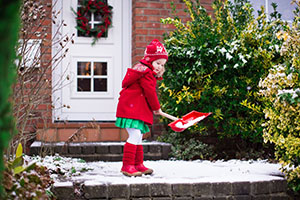1. To enter a car safely, the only thing in your hands should be your car keys, says a website on safety. (Hardly helpful advice for parents with young children.) In fact, placing car seats into cars is hazardous even in good weather. It involves compromising your balance. Bending awkwardly. Standing on one leg. Having both hands occupied holding a large object, one that blocks your view, leaving no hand free to grip a stationary support.
2. Wintery weather adds hazards. No matter how well snow and ice is removed from parking areas and sidewalks, assume that wet, dark areas may be slippery. To enter a car, turn your back to the seat, place both feet firmly on the ground, swing your buttocks onto the seat and then swing your feet into the car. Reverse the process to exit. Note: open car doors are not reliable objects to grasp for support. Take care not to fall over a car seat you may have placed on the ground.
 3. Install and secure car seats before bringing infants into the car. Ideally, have cars parked in warm, well lit, and, if indoors, well ventilated areas. Infants are sensitive to carbon monoxide from car exhaust. Never leave children in idling cars, especially in poorly ventilated places. Outdoors, check that tailpipes are free of snow.
3. Install and secure car seats before bringing infants into the car. Ideally, have cars parked in warm, well lit, and, if indoors, well ventilated areas. Infants are sensitive to carbon monoxide from car exhaust. Never leave children in idling cars, especially in poorly ventilated places. Outdoors, check that tailpipes are free of snow.
4. Prepare yourself. Appropriate footwear is low heels and slip-resistant shoes. Leather soles on wet/icy surfaces are hazardous. Wear warm clothing even if going outside for only a minute or two. Feeling cold makes you rush, leading to carelessness. Clothing that has smooth finishes and is not bulky eases sliding in and out of the car seat. Wear gloves that allow maneuverability, to tighten seatbelt straps and adjust an infants’ clothing, for example. Avoid using sunglasses; moving from light to dark areas, or vice versa, may cause momentary vision issues, sufficient to cause falls.
 5. Plan and dress your kids for your trip. Don’t be tempted to keep kids in their indoor clothing for drives from one warm place to another. Dress them as if you’ll get stuck in a snowdrift – even when there is no snow. Cars break down and other unexpected events may occur. Carry a charged telephone. Know emergency telephone numbers en route. Know where you are going to park at each stop.
5. Plan and dress your kids for your trip. Don’t be tempted to keep kids in their indoor clothing for drives from one warm place to another. Dress them as if you’ll get stuck in a snowdrift – even when there is no snow. Cars break down and other unexpected events may occur. Carry a charged telephone. Know emergency telephone numbers en route. Know where you are going to park at each stop.
6. Evaluate adults who transport your children. Do they have the temperament to handle screaming infants and unruly children? Do they know that children who can usually get in and out of cars by themselves may need assistance in winter weather? Adults over the age of sixty-five are ten times more likely to be injured entering and exiting cars than younger adults. Accidents are far more common exiting cars than entering them.
7. Avoid dressing children in bulky clothing. Heavy snowsuits and padded coats make it difficult to properly tighten harnesses on car seats. In crashes, padding compresses, allowing slack. Allow less than one inch of movement in harnesses from side to side or front to back. For toddlers, secure harnesses and then place a blanket over the child. Make sure that infants’ faces remain uncovered.
8. In snow country, think sun. Position infants so that the sun does not shine in their eyes. The position of the sun changes with the time of day and the direction you drive. Moreover, sun exposure is cumulative over a lifetime, contributing to cataract formation. Snow, especially in hilly terrain, reflects the sun’s rays, increasing exposure. While most windshields are treated to filter out harmful rays, the glass in side and back windows generally is not. Consider having windows tinted, installing window shades, or getting sunglasses for older children.

9. Also, consider perspiration. Modern winter clothing is so effective in keeping children warm that in an overheated enclosure, they will perspire, wetting the clothing layer touching the skin. In cold weather, wet clothing loses its insulating ability. If the perspiring child is subsequently exposed to snow/rain/sleet, the rate of body heat loss is accelerated five-fold.
10. Infants do not catch colds from cold weather. Moreover, infants do not become ill from going from warm to cold environments. Take the necessary time to properly secure car seats and load the day’s paraphernalia, even if these actions require leaving car doors open for a while. Ditto for leaving car windows open to ensure proper ventilation.

